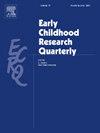家庭读写环境与中国儿童第二语言发展:一个交叉滞后分析
IF 3.1
1区 教育学
Q1 EDUCATION & EDUCATIONAL RESEARCH
引用次数: 0
摘要
本研究考察了家庭读写环境与中国儿童英语作为第二语言学习的语言和读写技能之间的交叉滞后关系。我们还调查了这种关系是否因儿童兴趣和家庭语言的使用而不同。241名儿童(女孩112名,年龄47.32个月)随访1年。交叉滞后路径分析显示,虽然读写资源和直接教学对儿童的英语技能有积极的预测作用,但儿童早期的语音意识和词汇也会影响父母后来的家庭读写实践。此外,高水平教育与儿童语言和读写能力之间的关系因儿童兴趣和家庭语言使用而异。这些发现揭示了儿童在塑造其HLE方面的积极作用。本文章由计算机程序翻译,如有差异,请以英文原文为准。
Home literacy environment and Chinese Children’s second language development: A cross-lagged analysis
This study examined the cross-lagged relations between the home literacy environment (HLE) and the language and literacy skills of Chinese children learning English as a second language. We also investigated whether the relations varied by child interest and home language use. A sample of 241 children (112 girls, Mage= 47.32 months) were followed for one year. Cross-lagged path analyses revealed that while literacy resources and direct teaching positively predicted children’s English skills, children’s earlier phonological awareness and vocabulary also influenced parents’ later home literacy practices. Furthermore, the associations between HLE and child language and literacy skills varied based on child interest and home language use. These findings shed light on children’s active role in shaping their HLE.
求助全文
通过发布文献求助,成功后即可免费获取论文全文。
去求助
来源期刊

Early Childhood Research Quarterly
Multiple-
CiteScore
7.00
自引率
8.10%
发文量
109
期刊介绍:
For over twenty years, Early Childhood Research Quarterly (ECRQ) has influenced the field of early childhood education and development through the publication of empirical research that meets the highest standards of scholarly and practical significance. ECRQ publishes predominantly empirical research (quantitative or qualitative methods) on issues of interest to early childhood development, theory, and educational practice (Birth through 8 years of age). The journal also occasionally publishes practitioner and/or policy perspectives, book reviews, and significant reviews of research. As an applied journal, we are interested in work that has social, policy, and educational relevance and implications and work that strengthens links between research and practice.
 求助内容:
求助内容: 应助结果提醒方式:
应助结果提醒方式:


